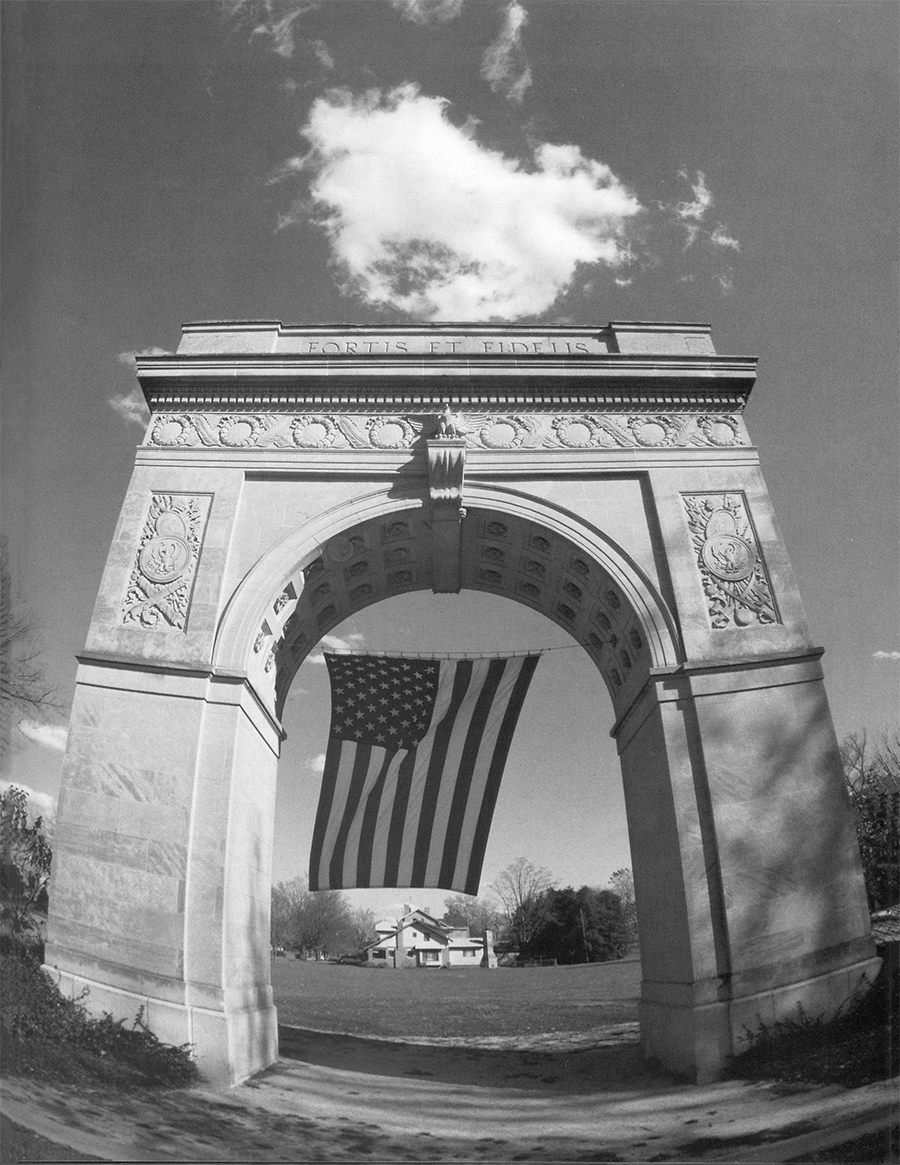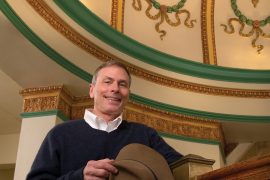By Joseph Platania
HQ 27 | WINTER 1997
Driving along Huntington’s Memorial Boulevard near Fourpole Creek, a structure
that is unique in West Virginia dominates the skyline. It is the Memorial Arch which, since November 1929, has stood at the intersection of 11th Avenue West and Memorial Boulevard. The clean lines of this impressive and graceful arch reflect the solemn nature of its purpose as a tribute to Cabell County soldiers who fought in “the war to end all wars” – World War I.
The 42-foot high, 34-foot wide and nine-foot thick Arc de Triomphe style edifice has an exterior made of Indiana limestone, destined to last for centuries. An inscription at the top reads: “To The Glory of God and The Honor of The Men of Cabell County Who Served Faithfully in the Great War.”
On the left buttress of the east side is carved the discharged World War I soldier’s button and on the right side is the seal of the State of West Virginia. Other appropriate inscriptions, insignia and artistic trimmings have been carved in bas-relief on both sides of the monument.
The Memorial Arch guards the gateway to Memorial Boulevard, which goes through 18-acre Memorial Park from 6th Street West to 14th Street West on the north side of Fourpole Creek. Flanking the boulevard on both sides are 91 towering trees, each one dedicated to a Cabell County soldier who gave his life in World War I.
The trees were planted in the early 1920s and each tree was numbered – the odd numbers were planted on the south side of the drive and the even numbers along the north. According to a newspaper article, “the first tree on Memorial Boulevard was planted in 1920 by Mayor C. W. Campbell and Thomas F. Bailey, president of the Rotary Club.” The roster of the number of each tree and the name of the soldier to whom it is dedicated is contained in the records of the Greater Huntington Park and Recreation District. At one time metal crosses donated by Huntington’s International Nickel Company stood in front of each tree. They have long since disappeared. According to the original concept for Memorial Park, “the trees are for those who have fallen; the arch is for all who served.”
World War I was the bloodiest conflict in which American soldiers had been engaged since the Civil War. From April 6, 1917 to November 11, 1918, nearly 4. 7 5 million Americans had wartime service and 116,708 died – 53,513 in battle, 63,195 in non-battle related deaths, many from disease such as the Spanish flu epidemic.
Memorial Park had its origin in the earliest days of planning for Huntington’s park system. After the war, the Rotary and Kiwanis clubs both appointed park committees to explore the acquisition of land. This resulted in a joint committee for the supervision of park development chaired by Col. George S. Wallace. In 1925, the committee’s work led to the West Virginia Legislature creating a Board of Park Commissioners for the city which was headed by Wallace.
A feature of the civic clubs’ plan “was a Memorial Boulevard for the World War soldiers to extend along the north bank of Fourpole Creek from 7th Street West to about 12th Street West,” states Wallace in his Cabell County Annals and Families. The county history adds that the plan called for the boulevard “to have memorial trees planted on each side and a proper memorial at the entrance to the driveway.”
In 1921, shortly after the proposal was made, an independent organization of business and professional men was formed, known as the Cabell County War Memorial Association. This group drafted plans for a boulevard and a suitable memorial. They were responsible for the erection of the Memorial Arch.
The monument was the brainchild of Huntington architect Jerry DeYoung. DeYoung served in France during World War I and, after the war, remained abroad for six months studying and painting watercolors of various forms of French and Italian architecture. The arch is considered his creation and is patterned after the Arc de Triomphe that stands on the Champs-Élysée in Paris.
After his return from Europe, De Young was employed by the Huntington architectural firm of Meanor and Handloser which was in charge of designing the memorial. Inspired by Paris’ famous arch, De Young designed a smaller version for the entrance to Memorial Boulevard. It was a structure that would take eight years to complete.
The excavation and foundation were done in 1921 “by men working under the supervision of Capt. Leroy McNulty” who was on the War Memorial Association’s material and building committee, states a newspaper article. The cement for the foundation was donated by Huntington companies and individuals such as W.W. Payne. The reinforcing steel was the gift of the city’s West Virginia Rail Company.
The cost of labor for the excavation and foundation work was paid by the Huntington Real Estate Board. The vision driving the construction of the memorial was that it was to be a community project.
In order to understand the scope of the project, a June 1924 newspaper article provided “a partial list of materials necessary to build the arch.” This included “50,000 bricks, 75 barrels of cement, 75 barrels of lime, 45 yards of gravel, 45 yards of sand and 1,500 cubic feet of cut stone.”
On Nov. 11, 1924, Armistice Day, the cornerstone for the arch was laid. The ceremony and a guest speaker drew a large crowd to the site. Col. C.D. Rhodes, who was considered “an outstanding figure in the military history of our country,” delivered an address, “Our Honored Dead,” states a newspaper account. The ceremony was followed by a parade comprised of local organizations, military bands, and “hundreds of patriotic citizens.”
The responsibility for the supervision of the arch’s construction was entrusted to Thomas Gracie, a stonecutter and founder of Gracie Stone and Monument Co. in Huntington. Mr. Gracie was a native of Glasgow, Scotland who came to Huntington in 1912 to help build a church and decided to stay. According to an article by Editor H.R. Pinckard in the Nov. 10, 1929, edition of The HeraldAdvertiser.
“Thomas Gracie’s name will ever be associated with the stone which clothes the steel-ribbed arch. He is a Scotchman and the story of his life is a colorful one. In Scotland years ago, he learned the trade of stonecutting, and he served in His Majesty’s army in the Boer War.”
In a November 1984 newspaper interview, Thomas Gracie’s son, James Gracie, recalled that his father came to Huntington “to build the Johnson Memorial Church (at corner of 5th Avenue and 10th Street) and he liked it here so much that he decided to stay.”
Contemporary newspaper accounts place the cost of the arch in the neighborhood of $40,000. It took the memorial association almost ten years to raise the money and much of the work and materials were donated.
After the laying of the cornerstone, the arch was built up to the “springers” (stones at the tops of the supportive columns or “imposts”) with money raised from the first fundraising drive by the association. At this point work ceased.
An article reports that a brick company in Portsmouth, Ohio, donated 50,000 paving bricks to the memorial association and were used for the construction of the arch’s interior.
In order to raise money for construction, performers were brought to Huntington by the memorial association. After shows and concerts raised money for the association’s coffers, work on the arch resumed.
In his 1929 article, editor Pinckard states that performers “whose concerts made much of the construction possible include Maria Jeritzen, (opera singer) Marion Talley, the U.S. Marine Band, Paul Whiteman and his orchestra, (violinist) Fritz Kreisler and others.”
The next phase of the work saw the springers put into place and the arch built up to the keystone at the apex, or center stones, of the edifice. Then there was another hiatus while new methods of fund raising were planned. Eventually, the money was raised and the frieze and two stone eagles were placed into position. The $500 cost of one of the stone eagles was paid by the Elks Club.
The arch’s exterior is made of Indiana limestone, known in the trade as Bedford Limestone.
A newspaper story reports that as a major part of the stonework progressed, the Cabell County Court, then the county’s governing body, donated $6,500 to the association which was used toward the carving work.
During the eight years of intermittent construction, the project was under the watchful eye of Gracie. In the Pinckard article, Wallace, who was then chairman of the park board and one of the men who was instrumental in fundraising for the arch, is quoted as saying about Gracie:
“He was always around the area when the stone was being put into place,” Wallace recalled. “Often he was in it. We would go there to look for him and frequently would not see him, but a call brought his head craning out of the interior like a jack-inthe-box.”
In the fall of 1929, work on the monument was completed. The ceremony of dedication of the Memorial Arch was held on Armistice Day, Nov. 11, 1929. All Huntington schools, Marshall College, municipal offices, banks and some places of businesses were closed for the hour of the ceremony. Before the dedication there was a parade which is described in a front page newspaper account:
“Flanked on either side of the street by thousands of people, with heads bared for the passage of the national colors, a huge Armistice Day parade, more than a mile long, replete in martial splendor, led what was probably Huntington’s greatest patriotic crowd to Memorial Park, where Cabell County’s Memorial Arch, a tribute to the World War dead, was dedicated.”
At the site, a bugler played “Taps” at 11 a.m. This was the hour when the armistice ending World War I was signed outside Paris on Nov. 11, 1918. This also was the hour when the arch was unveiled.
According to the dedication program, the presiding officer at the ceremony was to have been West Virginia Gov. William G. Conley. However, Conley was unable to attend because of a prior engagement. Instead Robert L. Archer, president of the War Memorial Association, presided at the ceremony.
An address, “The Completed Arch,” was given by Major General C. D. Rhodes, U.S. Army. Rhodes had spoken at the laying of the cornerstone in 1924.
The dedication address was given by U.S. Sen. Guy D. Goff of West Virginia. The unveiling was done by William Wallace and George S. Wallace, Jr.
Other guests at the ceremony and luncheon which followed included many officials of state government, members of the state supreme court, U.S. Circuit Judge George W. McClintic and John J. Cornwell, the state’s governor during the war years.
The newspaper account reports that a special choir, recruited from the city’s churches, sang at the dedication. Indicative of the new age of mass communications, the unveiling and the dedication service were broadcast live by Huntington’s new radio station, WSAZ, in a special Armistice Day program.
During the 1930s and 40s, classes of school children visited the memorial. However, by the late 30s attention was being focused on war clouds gathering over Europe and Asia that would lead to World War II. Later, there were wars in Korea and Vietnam, and the arch stood almost unnoticed as a monument from a bygone era.
The years of neglect ended in 1980 when Huntington’s Board of Park Commissioners authorized new landscaping of the grounds around the arch, installing lights and placing a large American flag in the monument. On special occasions, the 20 x 15 foot flag, which is specifically tailored to the arch, is hung between its supportive columns.
The revitalization of this landmark was supervised by parks’ director James L. McClelland. In 1979, McClelland, a native of Mount Lebanon, Pa., who had 16 years of experience in parks and recreation in Allegheny County, Wilkes-Barre, Buck Hill Falls and his hometown, was named executive director of Huntington’s park system. One of his first steps after assuming his new duties was to convince park commissioners of the need to upgrade the area around the memorial.
The renewed interest in the arch culminated with a rededication and lighting ceremony on July 3, 1980. More than a thousand people attended the ceremony including at least eight World War I veterans from the Tri-State area, their families and friends. A barbershop quartet sang World War I songs and other vocalists also performed. The arch was rededicated by Gov. Jay Rockefeller, who addressed the veterans and others at the ceremony:
“You were the doughboys who fought in the far-off fields of France and Germany and the ones for whom the names of Verdun and Flanders Field and all the other places across the sea have a special and terrible meaning. You are the ones, along with your fallen friends, for whom we are rededicating this memorial.”
In April 1981, the memorial was placed on the National Register of Historic Places by the U.S. Department of the Interior.
Since that time the memorial has been the site of many public functions. On Labor Day 1990, there was a gathering of local citizens to hear an address on the history and significance of the arch given by Jim McClelland, director of the Greater Huntington Park and Recreation District. McClelland states that, “The Memorial Arch is, because of its meaning and architecture, an edifice of which the park district is especially proud. There is nothing to compare to it in or around the State of West Virginia. We’re proud of all our facilities throughout the park district, however the Arch holds an exceptional place in our hearts.”
During the Persian Gulf War from the last week in January to April 1, 1991, the huge American flag flew day and night inside the arch in support of U.S. troops in Operation Desert Storm.
During this period of national crisis, a group of employees from the nearby former Owens-Illinois glass plant tied a yellow ribbon to each of the 91 trees in Memorial Park – trees that are dedicated to the Cabell County soldiers who died in World War I. The employees then held a ceremony at the arch to support U.S. troops in the Persian Gulf.
Almost all of West Virginia’s World War I doughboys are deceased or unable to attend a ceremony at the arch today. But their service to their country on foreign soil will never be forgotten as long as the Memorial Arch stands at the gateway to Memorial Park.





